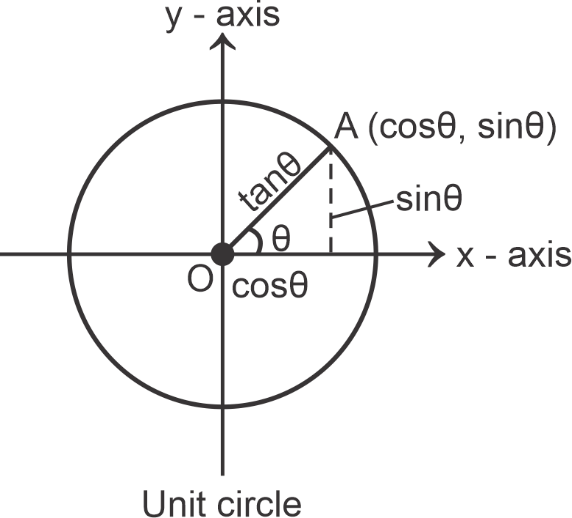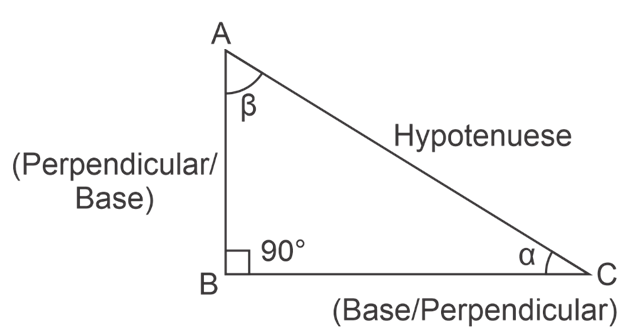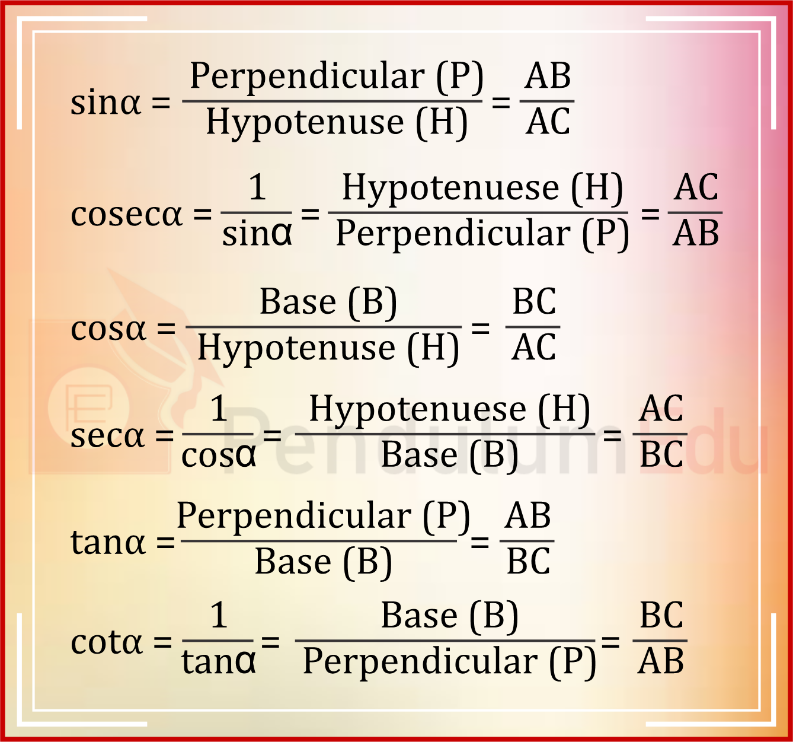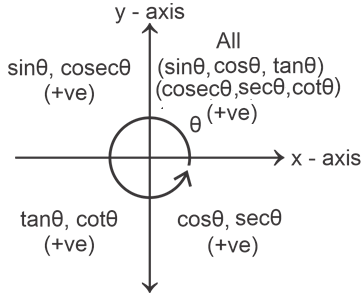Basics of Trigonometry, Trigonometric Identities, and Trigonometric Formulas
What is Trigonometry?
Trigonometry is the branch of mathematics that deals with the study of angles and sides of a triangle through different trigonometric ratios. Trigonometry is generally connected with the study of right-angle triangles but also applied to general triangles in the form of sine, cosine, and tangent laws. It is instrumental in astronomical studies and measuring the distance between Astronomical objects. Some significant branches of mathematics like Geometry, calculus, functions, and algebra are dependent on Trigonometry.
So, firstly we will discuss angles and how they are measured:
How Angles are measured?
Angles are measured in both degree and radian.
Most of the calculations in trigonometry are done in radians, so we should know the interconversion of degree and radian.
2π radian = 3600
There are majorly six types of trigonometric functions which are used in trigonometry to relate angles and sides in a right-angle triangle. These six functions are sine (represented as sin), cosecant (cosec), cosine (cos), secant (sec), tangent (tan) and cotangent (cot).
The values of these functions are basically calculated using a unit circle. A unit circle is a circle having a radius of 1 unit. Also, co-ordinates of a unit circle are (cos Ɵ, sin Ɵ).

We can calculate the relationship between sides, angles and trigonometric function through a right-angle triangle as follows:

In a right-angled triangle side opposite to the 900 angle is known as hypotenuse. While side adjacent to the angle in consideration is known as base or adjacent while side opposite to the angle in consideration is known as perpendicular or opposite. Therefore, for angle ‘α’, side BC is the base and side AB is the perpendicular, while for angle ‘β’, side AB is the base and side BC is the perpendicular.
Now, all the trigonometric ratios for ∆ ABC can be defined as:

While, when we consider ‘β’ as the angle in consideration, then the trigonometric function will change accordingly.
Important Trigonometric Ratios and Relations
We should remember the values of trigonometric functions for all important angles because without that, we would not be able to solve the questions in the paper. Let us see and learn the values of trigonometric functions at important angles:
| Trigonometric Functions | sin | cos | tan | cosec | sec | cot |
| \(0 ^\circ\) or 0π | 0 | \(1\) | 0 | Undefined | \(1\) | undefined |
| \(30 ^\circ\) or π/6 | \(\dfrac{1}{2}\) | \(\dfrac{\sqrt3}{2}\) | \(\dfrac{1}{\sqrt{3}}\) | 2 | \(\dfrac{2}{\sqrt{3}}\) | \(\sqrt{3}\) |
| \(45 ^\circ\) or π/4 | \(\dfrac{1}{\sqrt{2}}\) | \(\dfrac{1}{\sqrt{2}}\) | \(1\) | \(\sqrt{2}\) | \(\sqrt{2}\) | \(1\) |
| \(60 ^\circ\) or π/3 | \(\dfrac{\sqrt3}{2}\) | \(\dfrac{1}{2}\) | \(\sqrt{3}\) | \(\dfrac{2}{\sqrt{3}}\) | \(2\) | 13\(1 \over {\sqrt3}\) |
| \(90 ^\circ\) or π/2 | \(1\) | 0 | Undefined | 1 | Undefined | 0 |
| \(135 ^\circ\) or 3π/4 | \(\dfrac{1}{\sqrt{2}}\) | \(-\dfrac{1}{\sqrt{2}}\) | \(-1\) | \(\sqrt{2}\) | \(-\sqrt{2}\) | \(-1\) |
| \(180 ^\circ\) or π | 0 | -1 | 0 | Undefined | -1 | undefined |
| \(225 ^\circ\) or 5π/4 | \(-\dfrac{1}{\sqrt{2}}\) | \(-\dfrac{1}{\sqrt{2}}\) | 1 | \(-\sqrt{2}\) | \(-\sqrt{2}\) | 1 |
| \(270 ^\circ\) or 3π/2 | \(-1\) | 0 | Undefined | \(-1\) | Undefined | 0 |
| \(315 ^\circ\) or 7π/4 | \(-\dfrac{1}{\sqrt{2}}\) | \(\dfrac{1}{\sqrt{2}}\) | -1 | \(-\sqrt{2}\) | \(-\sqrt{2}\) | -1 |
| \(360^\circ\) or 2π | 0 | 1 | 0 | Undefined | 1 | undefined |
Other than these values some other values are also asked very frequently in exams;
sin370=\(\dfrac{3}{5}\),cos370=\(\dfrac{4}{5}\) andtan370=\(\dfrac{3}{4}\)
sin530=\(\dfrac{4}{5}\),cos530=\(\dfrac{3}{5}\) andtan530=\(\dfrac{4}{3}\)
sin150=\(\dfrac{{\sqrt3-1}}{{2\sqrt2}}\), cos150=\(\dfrac{{\sqrt3+1}}{{2\sqrt2}}\) andtan150=\(\dfrac{{\sqrt3-1}}{{\sqrt3+1}}\)=\(2-\sqrt3\)
sin750=\(\dfrac{{\sqrt3+1}}{{2\sqrt2}}\), cos750=\(\dfrac{{\sqrt3-1}}{{2\sqrt2}}\) and tan750=\(\dfrac{{\sqrt3+1}}{{\sqrt3-1}}\)=\(2+\sqrt3\)
sin22.50=\(\dfrac{\sqrt{2-\sqrt{2}}}{2}\), cos22.50=\(\dfrac{\sqrt{2+\sqrt{2}}}{2}\) and tan22.50=\(\sqrt2-1\)
Range and Domain of trigonometric functions
| Trigonometric function | Range | Domain |
| sin Ɵ | - 1 to 1 | -∞ to ∞ |
| cos Ɵ | - 1 to 1 | -∞ to ∞ |
| tan Ɵ | -∞ to ∞ | All real no. except π/2 + nπ |
| cosec Ɵ | (- ∞ to -1) ∪ (1 to ∞) | All real no. except nπ |
| sec Ɵ | (- ∞ to -1) ∪ (1 to ∞) | All real no. except π/2 + nπ |
| cot Ɵ | -∞ to ∞ | All real no. except nπ |
SIGN OF TRIGONOMETRIC FUNCTIONS IN DIFFERENT QUADRANTS

Interconversion of Trigonometric functions
sin (900 – Ɵ) = cos Ɵ
cos (900 – Ɵ) = sin Ɵ
sec (900 – Ɵ) = cosec Ɵ
cosec (900 – Ɵ) = sec Ɵ
tan (900 – Ɵ) = cot Ɵ
cot (900 – Ɵ) = tan Ɵ
sin (1800 – Ɵ) = sin Ɵ
cos (1800 – Ɵ) = - cos Ɵ
tan (1800 – Ɵ) = - tan Ɵ
NOTE: In case of conversion + and – signs are considered according to the sign of function in a quadrant.
Also, sin (-Ɵ) = - sin Ɵ
cos (-Ɵ) = cos Ɵ
tan (-Ɵ) = - tan Ɵ
cosec (-Ɵ) = - cosec Ɵ
sec (-Ɵ) = sec Ɵ
cot (-Ɵ) = - cot Ɵ
Pythagorean Identities
sin2 Ɵ + cos2 Ɵ = 1
sec2 Ɵ – tan2 Ɵ = 1
cosec2 Ɵ – cot2 Ɵ = 1
Double and triple angle formulae
\(sin 2Ɵ=2 sin Ɵ cos Ɵ=\dfrac{2tanƟ}{1+tan^2Ɵ}\)
\(cos^ 2Ɵ = cos^2 Ɵ – sin^2 Ɵ = 1 – 2 sin2Ɵ = 2cos^² Ɵ – 1\)
\(cos2Ɵ=\dfrac{1-tan^² Ɵ}{1+tan^²Ɵ}\)
\(tan 2Ɵ=\dfrac{2tanƟ}{1-tan^² Ɵ}\)
\(sin 3Ɵ = 3 sin Ɵ – 4 sin^3 Ɵ\)
\(cos 3Ɵ = 4 cos^3 Ɵ – 3 cos Ɵ\)
\(tan3Ɵ=\dfrac{3tanƟ-tan^3Ɵ}{1-3tan^2Ɵ}\)
\(tan\dfrac{Ɵ}{2}=\dfrac{sinƟ}{1+cosƟ}=\dfrac{1-cosƟ}{sinƟ}=\sqrt{\dfrac{1-cosƟ}{1+cosƟ}}\)
SOME USEFUL TRIGONOMETRIC RESULTS AND FORMULAE
Type 1:
sin (A + B) = sin A cos B + cos A sin B
sin (A – B) = sin A cos B – cos A sin B
cos (A + B) = cos A cos B – sin A sin B
cos (A – B) = cos A cos B + sin A sin B
\(tan(A+B)=\dfrac{tanA+tanB}{1-tanAtanB}\)
\(tan(A-B)=\dfrac{tanA-tanB}{1+tanAtanB}\)
\(cot(A+B)=\dfrac{cotAcotB-1}{cotA+cotB}\)
\(cot(A+B)=\dfrac{cotAcotB+1}{cotB-cotA}\)
Type 2:
sin (A + B) + sin (A – B) = 2 sin A cos B
sin (A + B) – sin (A – B) = 2 cos A sin B
cos (A + B) + cos (A – B) = 2 cos A cos B
cos (A + B) – cos (A – B) = – 2 sin A sin B
Type 3:
\(sinA+sinB=2sin(\dfrac{A+B}{2})cos(\dfrac{A-B}{2})\)
\(sinA-sinB=2cos(\dfrac{A+B}{2})sin(\dfrac{A-B}{2})\)
\(cosA+cosB=2cos(\dfrac{A+B}{2})cos(\dfrac{A-B}{2})\)
\(cosA-cosB=2sin(\dfrac{A+B}{2})sin(\dfrac{B-A}{2})\)
Type 4:
sin (A + B) × sin (A – B) = sin2 A – sin2 B = cos2 B – cos2 A
cos (A + B) × cos (A – B) = cos2 A – sin2 B = cos2 B – sin2 A
Type 5:
sin4 Ɵ + cos4 Ɵ = 1 – 2 sin2 Ɵ cos2 Ɵ
sin6 Ɵ + cos6 Ɵ = 1 – 3 sin2 Ɵ cos2 Ɵ
Type 6:
(sec Ɵ – tan Ɵ) (sec Ɵ + tan Ɵ) = 1
(cosec Ɵ – cot Ɵ) (cosec Ɵ + cot Ɵ) = 1
Type 7:
sin Ɵ sin (60 – Ɵ) sin (60 + Ɵ) =\(1 \over 4\)sin3Ɵ
cos Ɵ cos (60 – Ɵ) cos (60 + Ɵ) =\(1 \over 4\)cos3Ɵ
tan Ɵ tan (60 – Ɵ) tan (60 + Ɵ) = tan 3Ɵ
TYPE 8: If A + B = 450 or π/4
(tan A + 1) (tan B + 1) = 2
(cot A – 1) (cot B – 1) = 2
Type 9: If A + B + C = 1800
tan A + tan B + tan C = tan A × tan B × tan C
cot A cot B + cot B cot C + cot C cot A = 1
Type 10:
\(tanA+B+C=\dfrac{tanA+tanB+tanC-tanA\:tanB\:tanC}{1-tanA\:tanB-tanB\:tanC-tanC\:tanA}\)
sin (A + B + C) = sin A cos B cos C + sin B cos A cos C + sin C cos A cos B – sin A sin B sin C
cos (A + B + C) = cos A cos B cos C – cos A sin B sin C – cos B sin A sin C − cos C sin A sin B
MAXIMA AND MINIMA OF SOME GENERAL FUNCTIONS
| FUNCTION | MINIMA | MAXIMA |
| sin2 Ɵ, cos2 Ɵ | 0 | 1 |
| a.sin Ɵ ± b.cos Ɵ | \(-\sqrt{a^2+b^2}\) | \(\sqrt{a^2+b^2}\) |
| a.sin Ɵ ± b.sin Ɵ |
\(-\sqrt{a^2+b^2}\) | \(\sqrt{a^2+b^2}\) |
| a.cos Ɵ ± b.cos Ɵ | \(-\sqrt{a^2+b^2}\) | \(\sqrt{a^2+b^2}\) |
| (sinn Ɵ cosn Ɵ) | If n is even, min = 0 If n is odd, min = -\(({1\over2})^n\) | \(({1\over2})^n\) |
| a.sin2 Ɵ + b.cosec2 Ɵ | If a < b Min = a + b If a > b Min=\(2\sqrt{ab}\) | ∞ |
| a.cos2 Ɵ + b.sec2 Ɵ | If a < b Min = a + b If a > b Min=\(2\sqrt{ab}\) | ∞ |
| a.tan2 Ɵ + b.cot2 Ɵ | \(2\sqrt{ab}\) | ∞ |




 Latest
Latest 



Comments